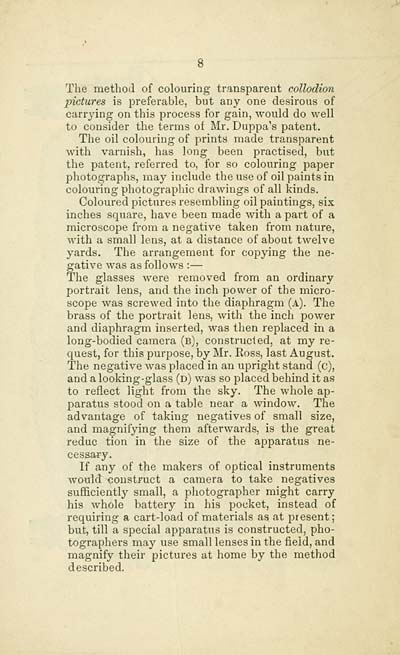Download files
Complete book:
Individual page:
Thumbnail gallery: Grid view | List view

8
The method of colouring transparent collodion
pictures is preferable, but any one desirous of
carrying on this process for gain, would do well
to consider the terms of Mr. Duppa's patent.
The oil colouring of prints made transparent
with varnish, has long been practised, but
the patent, referred to, for so colouring paper
photographs, may include the use of oil paints in
colouring photographic drawings of all kinds.
Coloured pictures resembling oil paintings, six
inches square, have been made with a part of a
microscope from a negative taken from nature,
with a small lens, at a distance of about twelve
yards. The arrangement for copying the ne-
gative was as follows : —
The glasses were removed from an ordinary
portrait lens, and the inch power of the micro-
scope was screwed into the diaphragm (a). The
brass of the portrait lens, with the inch power
and diaphragm inserted, was then replaced in a
long-bodied camera (b), constructed, at my re-
quest, for this purpose, by Mr. Ross, last August.
The negative was placed in an upright stand (c),
and a looking-glass (d) was so placed behind it as
to reflect light from the sky. The whole ap-
paratus stood on a table near a window. The
advantage of taking negatives of small size,
and magnifying them afterwards, is the great
reduc tion in the size of the apparatus ne-
cessary.
If any of the makers of optical instruments
would construct a camera to take negatives
sufficiently small, a photographer might carry
his whole battery in his pocket, instead of
requiring a cart-load of materials as at present;
but, till a special apparatus is constructed, pho-
tographers may use small lenses in the field, and
magnify their pictures at home by the method
described.
The method of colouring transparent collodion
pictures is preferable, but any one desirous of
carrying on this process for gain, would do well
to consider the terms of Mr. Duppa's patent.
The oil colouring of prints made transparent
with varnish, has long been practised, but
the patent, referred to, for so colouring paper
photographs, may include the use of oil paints in
colouring photographic drawings of all kinds.
Coloured pictures resembling oil paintings, six
inches square, have been made with a part of a
microscope from a negative taken from nature,
with a small lens, at a distance of about twelve
yards. The arrangement for copying the ne-
gative was as follows : —
The glasses were removed from an ordinary
portrait lens, and the inch power of the micro-
scope was screwed into the diaphragm (a). The
brass of the portrait lens, with the inch power
and diaphragm inserted, was then replaced in a
long-bodied camera (b), constructed, at my re-
quest, for this purpose, by Mr. Ross, last August.
The negative was placed in an upright stand (c),
and a looking-glass (d) was so placed behind it as
to reflect light from the sky. The whole ap-
paratus stood on a table near a window. The
advantage of taking negatives of small size,
and magnifying them afterwards, is the great
reduc tion in the size of the apparatus ne-
cessary.
If any of the makers of optical instruments
would construct a camera to take negatives
sufficiently small, a photographer might carry
his whole battery in his pocket, instead of
requiring a cart-load of materials as at present;
but, till a special apparatus is constructed, pho-
tographers may use small lenses in the field, and
magnify their pictures at home by the method
described.
Set display mode to: Large image | Transcription
Images and transcriptions on this page, including medium image downloads, may be used under the Creative Commons Attribution 4.0 International Licence unless otherwise stated. ![]()
| Early Gaelic Book Collections > J. F. Campbell Collection > Method of converting collodion negatives into positives, by heat > (8) |
|---|
| Permanent URL | https://digital.nls.uk/80584530 |
|---|
| Description | Volumes from a collection of 610 books rich in Highland folklore, Ossianic literature and other Celtic subjects. Many of the books annotated by John Francis Campbell of Islay, who assembled the collection. |
|---|
| Description | Selected items from five 'Special and Named Printed Collections'. Includes books in Gaelic and other Celtic languages, works about the Gaels, their languages, literature, culture and history. |
|---|
